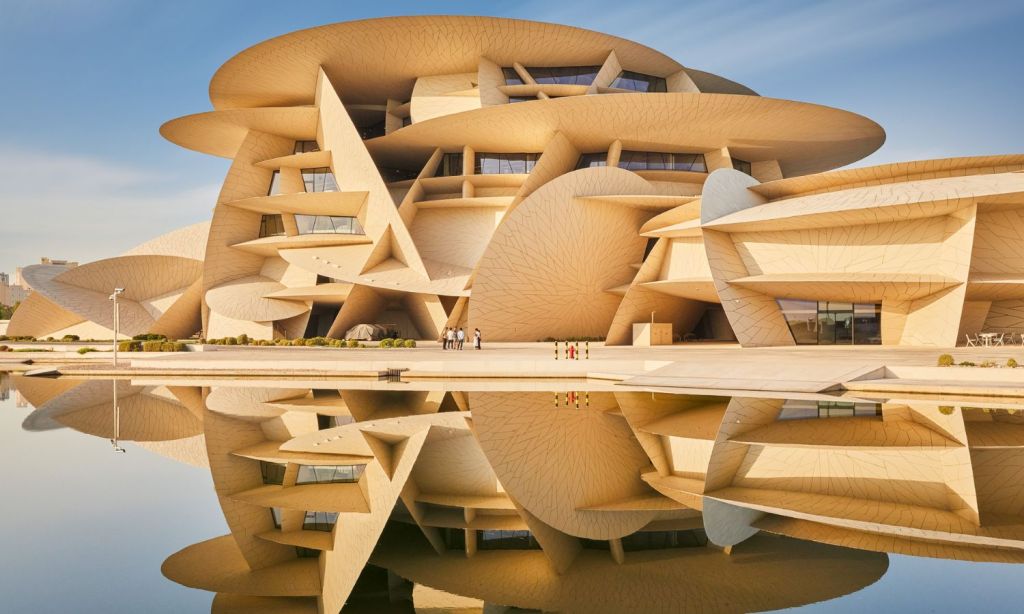From a mosque that can hold over 30,000 worshippers, to a light-filled library with over one million books and automatic book sorting, there are a number of stunning delights to be found in Doha, the capital city of Qatar.
Given that both Qantas and Virgin partner with Qatar Airways, a stopover in Doha’s Hamad International Airport might be a part of your itinerary so why not get out and explore? If that’s what you’re doing, below, we’re rounded up some of the best architectural spots to see while you’re there.
Related: Artificial Architecture Is the Calming Inspo Your Insta Feed Needs
Related: Biophilic Design Aims to Improve Well-Being, But Can It Help the Planet, Too?
Museum of Islamic Art

Conceived by Pritzker Prize-winning architect I.M. Pei, best known for designing the glass pyramid in the forecourt of the Louvre in Paris, this museum sits on a purpose-built island off Doha’s central waterfront promenade.
The building was inspired by the Sabil, also known as an ablution fountain, in the 9th-century Mosque of Ahmad Ibn Tulun in Cairo, Egypt. Traditional Islamic building features, including domes, geometric patterns, arches, and water features, blend with modern architecture to create this must-visit museum.
Msheireb Downtown Doha

The Msheireb Museums celebrate the history of Qatar through four heritage houses in the heart of Msheireb, downtown Doha, an area that includes entertainment venues, Qatar Academy Msheireb, and four hotels, the Mandarin Oriental Doha, Al Wadi Hotel MGallery, Park Hyatt Hotel, and a boutique. MDD will also soon house the Doha Design District, a cultural hub for regional and international talent.
National Musem of Qatar

The National Museum of Qatar’s striking façade features interlocking cantilevered disks, with the museum spanning 430,500 square feet. Designed by Pritzker Prize-winning architect Jean Nouvel, the NMoQ draws inspiration from the country’s history and its geology.
The museum itself recreates a naturally occurring mineral crystal formation known as the ‘desert rose’. Occurring solely in arid coastal regions, the desert rose is a natural architectural structure, made through the interaction of wind, sea spray, and sand over millennia.
Imam Abdul Wahhab

The largest mosque in Qatar is the Imam Abdul Wahhab, also known as the Qatar State Grand Mosque. Designed with simple lines and graceful arches, characteristic of Islamic architectural tradition, the mosque can hold over 30,000 worshippers. It houses three libraries, and prayer and ablution halls for men and women.
Al Janoub Stadium

One of eight venues to host the FIFA World Cup Qatar 2022, Al Janoub Stadium, was designed by the late British-Iraqi architect Zaha Hadid. Located near the former fishing town of Wakrah, it draws inspiration from the traditional dhow boats, which dot Qatar’s waters, and the pearls that are integral to the country’s economy. Post-competition, the stadium is being used as a local community venue.
Qatar National Library

Designed by Rem Koolhaas, the Qatar National Library has a spacious interior that prioritises light and visibility. The library has over one million books, which are organised using automatic sorting that’ll bring up any collection. A heritage library in the basement of the diamond-shaped building holds documents dating to the 7th century A.D.
Katara Mosque at Katara Cultural Village

Designed by Turkey’s Zeynep Fadilloglu, who is believed to be the first female architect to specialise in mosques, the mosque features Persian and Turkish tile and enamel work in shades of blue and gold. It’s a stark contrast to its sandy-coloured, surrounding buildings.
The minaret, dome, and prayer niche (mihrab) feature décor inspired by the Dolmabahçe Palace in Istanbul, as well as from other famous mosques across the Muslim world. Next to the mosque, one can see the unmistakable pigeon towers, oblong structures with holes and perches for pigeons.
Note: Qatar has a well-documented history of human rights violations, so if you are considering visiting, it’s advised you do your own research before the trip and, during it, be sure to abide by the country’s rules.
Read more stories from The Latch and subscribe to our email newsletter.







